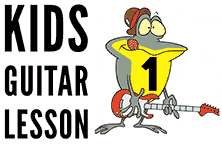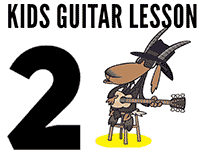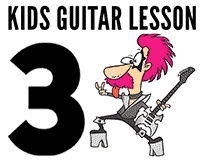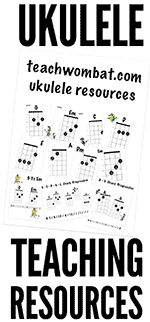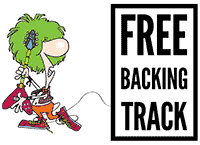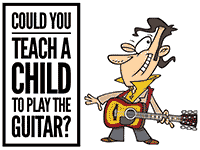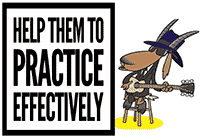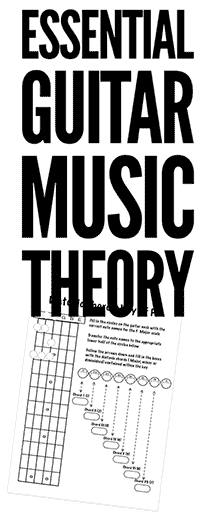
Kids Guitar Lesson 1: Lesson Plan
You can probably download all of the backing tracks and handouts on this website to your phone and run your lessons with nothing more than a smart phone and a guitar.
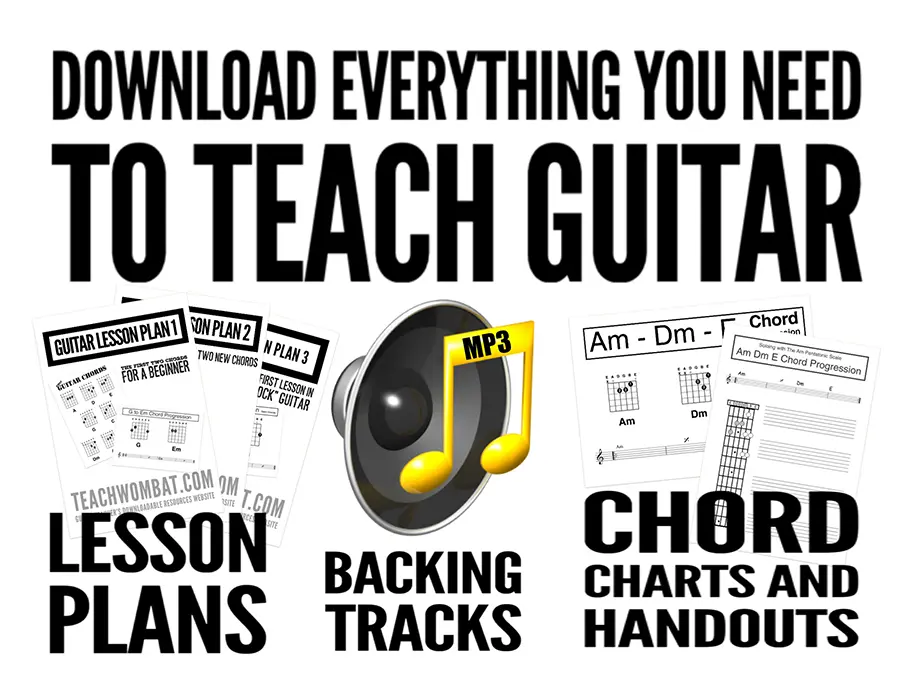
$25.00
The Lesson
Step 1: Make sure the guitar is in tune
There are many free guitar tuning apps for iphones and androids that you can download to your phone, tablet or PC and loads of videos up there on youtube that let you know how to use them. Whichever way you choose to get to the point that the guitar is in tune it is important to remember that even if the correct fingers are being deployed properly and the guitar is being strummed or picked in perfect rhythm if it is not in tune it will sound awful!
Anyways........ back to the lesson............
Step 2: Show the child how to play the G Chord


Not just for smaller hands
Even for kids who do not have particularly small hands it can be a great idea during the first few lessons to use the "reduced" one finger guitar chords shown above as the simplicity of learning two shapes which use only a single finger (the third) of the left hand produces impressive sounding results from the beginning and helps to create a "Hey! can do this!" effect
It is important that the third finger is used to play both shapes as when the "full" versions of the chords are covered during the course of the next few lessons the student will only have to add more fingers to the shapes that he or she already knows rather than learning a whole new chord
Step 3: Show your student how to form the Em chord

The material referenced above features a "reduced" one finger version of the Em chord but the reality is that the full version of the chord (introduced in the next lesson) will present no problem with regard to stretching for even the smallest hands. The one finger shape presented here is really used for the sake of simplicity and to get a child off to a flying start. If you wish it is perfectly possible to use the full Em shape if desired.
Step 4: Have your student(s) move repeatedly between the chord shapes in their own time
This is an important stage and (although we sell chord charts etc) it is important to realise that "the knowledge is no good if it stays on the paper" Be sure that a child can play the two shapes from memory without access to the charts before moving on to the next stage
IMPORTANT!
The only two things you need to pay attention to at this stage of learning.......
1: They will change between the two chords slowly
Hardly surprising really because just a few minutes ago they didn't know any guitar chords at all but because the two shapes are simple (and use the same finger) it does not take long at all to learn to move between them
and........
2: The finger used to form the chord will sometimes "kill" one or more of the strings that are supposed to be ringing out when the chord is strummed
This is perfectly normal and is not a problem as it can be easily and effectively addressed in the next stage when the backing track for this lesson comes into play and you can help the child to improve by encouraging them to arch the fingers of their fretting hand so that they press the strings down with their finger tips rather than allowing their fingers to deaden the strings that they are not supposed to be fretting
I have been teaching kids to play guitar for most of my life and to be honest this is just about the only thing you have to pay attention to at this stage of learning
The importance of using backing tracks
Playing guitar along to backing tracks solves the problem as changing repeatedly between the chords makes children better at it and that is the case with all eight of the chords that any beginner needs to learn first
Step 5: Introduce a count of 1-2-3-4
Playing the guitar is about more than learning chord shapes. Every bit as important is the (often overlooked at this stage) ability to strum a chord in time to an instruction or with other musicians. This is a great time to introduce the concept of tempo and "counting in"
Have your student count rhythmically from one to five. Then have them count and replace the word "five" with a single downward strum of the G chord. Do the same with the Em chord and repeat the process for a few minutes until they get used to the idea of replacing "five" with a single strum. It seems like a small thing but it really is quite an important skill. Being able to respond in time to whatever else is going on is an absolutely fundamental musical skill and is vital before progressing to the final part of this first lesson (where the FUN is!)

Step 6: Play along to a backing track

Click above to hear a snippet of the simple guitar and bass backing track that goes along with this lesson
Download a set of free kids guitar lesson plans
Our free stuff is free with no strings attached! We don't want your email address and you don't have to sign up to anything Just click and download!
Free lesson plans
Download Children's Guitar Lesson Plan 2
Download Children's Guitar Lesson Plan 3
Download Children's Guitar Lesson Plan 4
Download Children's Guitar Lesson Plan 5
More about the Backing Tracks
We have a whole load of backing tracks for beginners and we have recently introduced a whole load of guitar backing tracks for intermediate and more advanced players that you can hear if you follow this link The new tracks are perfect for musicians of any age who have mastered the basics and are ready to move on to more advanced materials
Play the backing track (did I mention that there are 35 of them in the download?) where the chords change from G to Em (two bars of each chord repeated for a few minutes). As the track plays speak to them and let them know when the chord is changing (say something like .........."G......1-2-3-4") Continue with this "counting in" for as long as required. The important thing is that the child is getting used to changing between chord shapes in time to music.
It can also be helpful (and fun) to ask children to sing along with the strumming pattern that they are using. For the "down-up-down-up" strumming pattern used in the video below I currently use the phrase "sau-sage-and-chips". Using this sing along technique is not just for fun though as kids who may struggle when being asked to play an unfamiliar set of "down-up-down-up" movements with their strumming hand often find the task easy when joining in with the sound of their own voices.
Step 7: Give out the certificate of achievement for this lesson and encourage the child (or children if you are teaching a group) to practice before the next session. Let them know what comes next (the chords of C and D)

Children Love To Have Their Hard Work Recognised
I have been teaching children to play guitar for more years than i like to admit but even I was stunned by how effective the certificates were when I started to use them in my own lessons
They can go up on bedroom walls or on the fridge to remind students that their efforts are appreciated and to remind parents why they are paying you
$25.00
You can download absolutely everything you see and hear on this website (thats over 450 PDFs and 35+ Backing Tracks) for only $25.00
Rather than divide the materials into a series of individual teaching packs and sell them separately (as I have been advised to do on numerous occasions by folks who understand much more about this online marketing thing than I do) I would much rather just bundle all of the guitar teaching materials together in one download and have folks feel like they got themselves a bargain rather than having to choose between a bewildering array of options and run the risk of selecting the wrong one
In addition to resources aimed at beginners and kids there are also a whole load of materials that can be used when teaching intermediate and more advanced guitar players
There are a whole load of resources designed for teaching music theory to guitar players and even stuff aimed at helping a teacher to understand how songwriting works on guitar
Add the material on teaching ukulele alongside the bass guitar teaching resources in addition to stuff geared towards teaching jazz guitar basics and you can see why I feel justified in claiming that the teachwombat download offers rediculously good value for money
Only the most advanced and versatile guitar teachers will use all of the materials but I think it is fair to claim that anyone who teaches guitar will find that the download makes their teaching better and the process easier
$25.00
How To Teach Kids Guitar
Childrens Guitar First Lessons
First Kids Guitar Lessons that you can give using your phone which introduces the eight chords that children should learn first
Find out more about these great kid's guitar lessons
Visit the links below to find out more and download more free resources.....
Go To Children's Guitar Lesson-2
Go To Children's Guitar Lesson-3
Go To Children's Guitar Lesson-4
Go To Children's Guitar Lesson-5

(above) a still from the short video on teaching children guitar
Video Walk-through of the
First Five Kid's Guitar Lessons
The (short) video below (which even makes sense with no sound at all) will take you quickly through the first five guitar lessons for a child
The lessons are themed around the "best" eight chords for any beginner (not just children) to learn and there are a series of strumming patterns that will develop a young player's guitar technique properly from the very first lesson
If you spend a few minutes with the video and read the material on this part of the website you will develop an effective overview of how to get children playing guitar "properly" and with very real results from a standing start
See the video on how to teach children guitar
The difference between teaching kids and adults to play guitar
The main difference between teaching adult beginners and teaching kids to play guitar is that during the early stages of study children are often presented with "reduced" one finger versions of some of the chords (G, C and sometimes Em) to take into account of the fact that their motor skills and dexterity may not yet be fully developed and that children with smaller hands may find it discouraging during the very early stages to stretch their fretting fingers over the entire width of a guitar neck (as they are required to do with the full G and C shapes).
It should be stressed that these shapes are only normally used during the first stages of playing and that within a few weeks kids are normally working with the "full" chord shapes quite happily
How to use the chord shapes

It is important to realise that the "reduced" one finger chord shapes are not different to the full shapes but rather that they are versions of the full shapes in which there is no need to use all of the fingers used in the full shape because you dont play all of the strings
In order to play the full chord children are just required to build on the knowledge and capability that they already have by adding fingers to the shape that they already know (see the graphic above)
The eight chords (C,A,G,E,D,Am,Dm and Em hence the common name for them-the CAGED System) have become accepted as being the best way to help a beginner to make rapid progress on the guitar and this first lesson uses two of those chords which use the same finger (the third) of the left hand to produce a (hopefully) pleasing sound.
It is important at this stage to stress that there are two things going on in this lesson. The first is for a child to learn the chord shapes and the second (just as important) outcome is to sound that chord in time to a backing track or at the very least a metronome. We sell backing tracks and handouts suitable for both kids and adults but the reality is that if you have the time and technology you could probably make your own.
This part of the site features five lessons designed to get kids off to a flying start on guitar and loads of freebies designed to help you to make your guitar teaching more effective and enjoyable. Every page features a free downloadable "at a glance" lesson plan like the one below (the pages themselves go into more detail about each session).
The five lessons are geared towards creating a situation where a child is comfortable forming and moving between the eight chords that guitar teachers the world over use to teach children and adults alike.

A whole load of resources designed to make teaching children to play the guitar easy and effective
There are resources that feature both "reduced" one finger chord shapes for smaller hands as well as sheets and chord charts that feature "full" chord shapes
There are also a whole load of Cretificates that you can award your students as lessons progress to reward and encourage them
There are also a whole load of child friendly blank chord, tab and guitar neck sheets so that you can create a library of your own custom built resources that you can use over and over again as required

Backing Tracks and Chord Charts
It does not matter if it is a child or an adult beginner they all need to learn the same eight chords at the start
The download contains 35 backing tracks with chord charts and handouts designed to help both kids and older learners alike If your guitar student can't play in time to music then they can't play guitar
It's as simple as that

Put together a library of teaching resources
A range of resources that will allow you to customise your teaching by preparing material for favourite lessons or in response to student requests The blanks in the download (of which you can see just a few above) come in both child friendly and regular standard versions
Take a look at the video below (which even makes sense with the sound muted) which looks at a method that uses this short series of five lessons proven to get kids off to a flying start on guitar
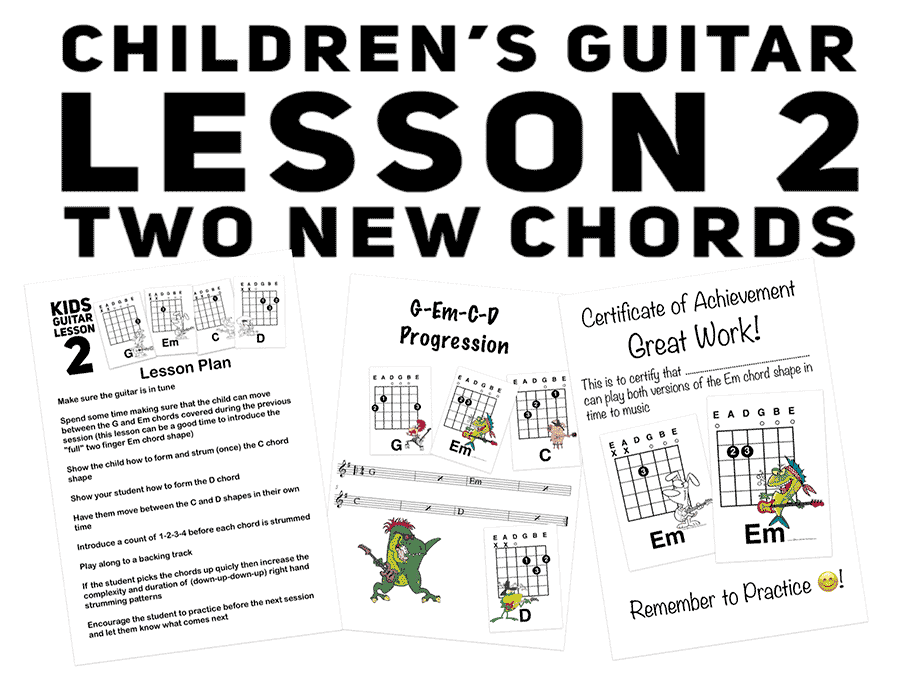
You can see another important certificate which can be awarded when students have mastered all eight chords and can move between them from the page Kids Guitar Lesson 5
If you are interested in the more theoretical side of teaching you could take a look at our guitar pedagogy page which looks at theory, technique and repertoire, the "three pillars of guitar teaching"
The Deluxe Package:
Download all of the resources on this website for just $25.00
Over 450 Sheets and 35 Backing tracks to Download and use TODAY!
Everything you need to start or improve a guitar teaching business! It's all there!
Only $25.00
HOW TO DOWNLOAD
the teachwombat materials
Buy your teachwombat.com toolkits in complete safety via any major credit card (through paypal) or directly through your paypal account if you have one. If you choose to use a credit card, rest assured that we never see your credit card details as paypal do all of that for us.
When Paypal receive your payment you will be immediately invited to click a
"RETURN TO MERCHANT"button.
You will be taken to a page from where you can download the products that you have paid for NOW!
In the (rare) event that something should go wrong with the order/download process just email me at robh@teachwombat.com
I will check the order and send you the links that will get you to your stuff.
Cheers! Rob!

